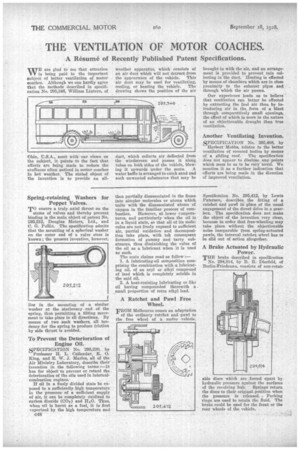Spring-retaining Washers for Poppet Valves.
Page 32

If you've noticed an error in this article please click here to report it so we can fix it.
TO ensure a truly axial thrust on the stems of valves and thereby prevent binding is the main object of patent No. 295,212, Douglas Motors, Ltd., and C. G. Pullin. The specification admits that the mounting of a spherical washer on the outer end of a valve stem is known ; the present invention, however,
lies in the mounting of a similar washer at the stationary end of the spring, thus permitting a tilting movement to take place in all directions. By means of two such washers, all tendency for the spring to produce friction by side thrust is avoided.
To Prevent the Deterioration of Engine Oil.
SPECIFICATION No. 295,230, by
Professor H. L. Callender, R. O. King, and E. W..1. Merles, all of the Air Ministry Laboratory, describe their Invention in the following terms :—It has for object to prevent or retard the deterioration of the oils used in internalcombustion engines.
If oil in a finely divided state be exposed to a sufficiently high temperature in the presence of a sufficient supply of air, it can be completely Oxidized to carbon dioxide (CO3) and HaO. Thus, when oil is burnt as a fuel, it is first vaporized by the high temperature Rini then partially disassociated in the flame into simpler molecules or atoms which unite with the disassociated atoms of oxygen in the familiar process of combustion. However, at lower tzmperatures, and particularly when the oil is in a liquid state, so that all of its molecules are not freely exposed to sufficient air, partial oxidation and decomposition take place, with teh consequent formation of gummy and tarry substances, thus diminishing the value of the oil as a lubricant when it is used as such.
The main claims read as follow :—
1.A lubricating-oil composition comprising the combination with a lubricating oil, of an aryl or alkyl compound of lead which is completely soluble in the said oil.
2. A heat-resisting lubricating or like oil having compounded therewith a _small proportion of tetra ethyl lead.
A Ratchet and Pawl Free Wheel.
FROM Melbourne comes an adaptation of the ordinary ratchet and pawl to the free wheel of a motor vehicle.
Specification No. 295,412, by Lewis Paterson, describes the fitting of a ratchet and pawl in place of the usual engagement of the direct drive in a gearbox. The specification does not make the object of the invention very clear, because in order that free-wheeling may take place without the objectionable noise inseparable from spring-actuated pawls, the internal ratchet wheel has to be slid out of action altogether.
A Brake Actuated by Hydraulic Power.
THE brake described in specification No. 294,814, by B. It. Dierfeld, of Berlin-Friedenau, consists of non-rotat able discs which are forced apart by hydraulic pressure against the surfaces of the revolving hub. Springs return the discs to their original position when the pressure is released. Packing rings are used to retain the fluid. The brake could be used for the front or the roar wheels of the vehicle.
































